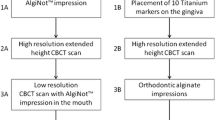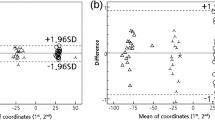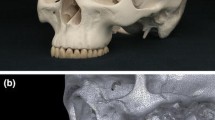Abstract
Purpose
Many artifacts and obstacles associated with cone-beam computed tomography (CBCT) scan can obscure or distort the details of the teeth and occlusal surface, like distorted teeth, streak artifacts, noise, and some malocclusion cases with excessive overlapping between jaws cause decrease the interocclusal space, which can impact diagnosis and treatment planning, and the 3D reconstruction accuracy. Optimizing dental precision by Integrating CBCT scans with other imaging modalities, supply more information to enhance CBCT accuracy, mainly in dental areas with limited clarity.
Methods
Performing the Structure-from-Motion (SfM) photogrammetry method, using phone camera and photograph studio setup using simple hardware, to digitize the dental casts and obtain an accurate digital dental model. Using this digital dental model to enhance dental precision in the CBCT data by performing the superimposition process, using a surface-based registration method and integration process to create a virtual dentoskeletal model. Evaluate the accuracy and quality of the superimposition results using qualitative (visual inspection) and quantitative measures.
Results
The differences between the virtual dentoskeletal model and the reference CBCT model are calculating by the 3D Euclidean distance, the mean ± SD are 0.212 ± 0.169 mm and 0.26 ± 0.149 mm for the maxilla and mandible, respectively. The color-coded map shows that the two surfaces are similar, but the extremist values are concentrated in the dental region due to the presence of the noise in the reference model and the gingiva in the virtual dentoskeletal model.
Conclusions
The resulting virtual dentoskeletal model can be viewed and manipulated on a computer screen, allowing for a detailed analysis of the teeth and supporting structures. The 3D model generated by the SfM photogrammetry technique did well during the superimposition process, representing a reliable method for virtual-based processing such as orthognathic surgery planning and splint design.









Similar content being viewed by others
Availability of data and materials
All data generated or analyzed during the present study are included in this published article.
References
Jain S, Choudhary K, Nagi R, Shukla S, Kaur N, Grover D (2019) New evolution of cone-beam computed tomography in dentistry: combining digital technologies. Imaging Sci Dent 49(3):179–190. https://doi.org/10.5624/isd.2019.49.3.179
Baumgaertel S, Palomo JM, Palomo L, Hans MG (2009) Reliability and accuracy of cone-beam computed tomography dental measurements. Am J Orthod Dentofac Orthop 136(1):19–25. https://doi.org/10.1016/j.ajodo.2007.09.016
Jacobs R, Salmon B, Codari M, Hassan B, Bornstein MM (2018) Cone beam computed tomography in implant dentistry: recommendations for clinical use. BMC Oral Health 18(1):1–16. https://doi.org/10.1186/s12903-018-0523-5
Nkenke E, Zachow S, Benz M, Maier T, Veit K, Kramer M, Benz S, Hausler G, Neukam FW, Lell M (2004) Fusion of computed tomography data and optical 3D images of the dentition for streak artefact correction in the simulation of orthognathic surgery. Dentomaxillofac Radiol 33(4):226–232. https://doi.org/10.1259/dmfr/27071199
Zou B, Kim J-H, Kim S-H, Choi T-H, Shin Y, Kook Y-A, Lee N-K (2022) Accuracy of a surface-based fusion method when integrating digital models and the cone beam computed tomography scans with metal artifacts. Sci Rep 12(1):8034. https://doi.org/10.1038/s41598-022-11677-9
Kudasik T, Miechowicz S (2016) Methods of reconstructing complex multi-structural anatomical objects with RP techniques. Bull Pol Acad Sci Techn Sci. https://doi.org/10.1515/bpasts-2016-0036
Baan F, Bruggink R, Nijsink J, Maal T, Ongkosuwito E (2021) Fusion of intra-oral scans in cone-beam computed tomography scans. Clin Oral Invest 25:77–85. https://doi.org/10.1007/s00784-020-03336-y
de Waard O, Baan F, Verhamme L, Breuning H, Kuijpers-Jagtman AM, Maal T (2016) A novel method for fusion of intra-oral scans and cone-beam computed tomography scans for orthognathic surgery planning. J Cranio-Maxillofac Surg 44(2):160–166. https://doi.org/10.1016/j.jcms.2015.11.017
Lin H-H, Chiang W-C, Lo L-J, Hsu SS-P, Wang C-H, Wan S-Y (2013) Artifact-resistant superimposition of digital dental models and cone-beam computed tomography images. J Oral Maxillofac Surg 71(11):1933–1947. https://doi.org/10.1016/j.joms.2013.06.199
Noh H, Nabha W, Cho J-H, Hwang H-S (2011) Registration accuracy in the integration of laser-scanned dental images into maxillofacial cone-beam computed tomography images. Am J Orthod Dentofac Orthop 140(4):585–591. https://doi.org/10.1016/j.ajodo.2011.04.018
Park J-H, Hwang C-J, Choi Y-J, Houschyar KS, Yu J-H, Bae S-Y, Cha J-Y (2020) Registration of digital dental models and cone-beam computed tomography images using 3-dimensional planning software: comparison of the accuracy according to scanning methods and software. Am J Orthod Dentofac Orthop 157(6):843–851. https://doi.org/10.1016/j.ajodo.2019.12.013
Rangel FA, Maal TJ, Bergé SJ, Kuijpers-Jagtman AM (2012) Integration of digital dental casts in cone-beam computed tomography scans. Int Sch Res Not. https://doi.org/10.5402/2012/949086
Rangel FA, Maal TJ, de Koning MJ, Bronkhorst EM, Bergé SJ, Kuijpers-Jagtman AM (2018) Integration of digital dental casts in cone beam computed tomography scans—a clinical validation study. Clin Oral Invest 22:1215–1222. https://doi.org/10.1007/s00784-017-2203-2
Swennen G, Barth E-L, Eulzer C, Schutyser F (2007) The use of a new 3D splint and double CT scan procedure to obtain an accurate anatomic virtual augmented model of the skull. Int J Oral Maxillofac Surg 36(2):146–152. https://doi.org/10.1016/j.ijom.2006.09.019
Swennen G, Mommaerts M, Abeloos J, De Clercq C, Lamoral P, Neyt N, Casselman J, Schutyser F (2009) A cone-beam CT based technique to augment the 3D virtual skull model with a detailed dental surface. Int J Oral Maxillofac Surg 38(1):48–57. https://doi.org/10.1016/j.ijom.2008.11.006
Swennen GR, Mollemans W, De Clercq C, Abeloos J, Lamoral P, Lippens F, Neyt N, Casselman J, Schutyser F (2009) A cone-beam computed tomography triple scan procedure to obtain a three-dimensional augmented virtual skull model appropriate for orthognathic surgery planning. J Craniofac Surg 20(2):297–307. https://doi.org/10.1097/SCS.0b013e3181996803
Swennen GR, Mommaerts MY, Abeloos J, De Clercq C, Lamoral P, Neyt N, Casselman J, Schutyser F (2007) The use of a wax bite wafer and a double computed tomography scan procedure to obtain a three-dimensional augmented virtual skull model. J Craniofac Surg 18(3):533–539. https://doi.org/10.1097/scs.0b013e31805343df
Yang W-M, Ho C-T, Lo L-J (2015) Automatic superimposition of palatal fiducial markers for accurate integration of digital dental model and cone beam computed tomography. J Oral Maxillofac Surg 73(8):1616. https://doi.org/10.1016/j.joms.2015.04.004
Piech I, Adam T, Dudas P (2022) 3D modelling with the use of photogrammetric methods. Arch Civ Eng. https://doi.org/10.24425/ace.2022.141898
Mahmood RS, Hamandi SJ, Al-Mahdi AH (2023) Creating a digital 3D model of the dental cast using structure-from-motion photogrammetry technique. Int J Online Biomed Eng (iJOE) 19(03):4–17. https://doi.org/10.3991/ijoe.v19i03.36289
Funding
The authors did not receive support from any organization for the submitted work.
Author information
Authors and Affiliations
Contributions
All authors contributed to the study conception and design. Material preparation, data collection and analysis were performed by RSM, SJH and AHA-M. The first draft of the manuscript was written by RSM, and all authors commented on previous versions of the manuscript. All authors read and approved the final manuscript.
Corresponding author
Ethics declarations
Conflict of interest
All authors declare that they have no conflicts of interest/competing interests.
Ethical approval
This study was performed in line with the principles of the Declaration of Helsinki. Approval was granted by the Ethics Committee of the Department of Biomedical Engineering in Al-Nahrain University, College of Engineering. Number 1/2020.
Consent to participate/consent for publication
In the current study, all patient data were obtained from Shahid Ghazi Hospital, a teaching hospital in Baghdad/Iraq. It is essential to note that prior to enrolling in this study, all patients were required to provide their informed consent to participate and have their information published. The process of obtaining consent involved ensuring that patients were fully informed about the nature and purpose of the study, the potential risks and benefits, and the confidentiality of their data. By obtaining consent, the study adheres to ethical principles that prioritize patient autonomy, privacy, and the responsible handling of their information. This consent process underscores the commitment to conducting research in a respectful and transparent manner, with due consideration for the rights and welfare of the patients involved.
Additional information
Publisher's Note
Springer Nature remains neutral with regard to jurisdictional claims in published maps and institutional affiliations.
Rights and permissions
Springer Nature or its licensor (e.g. a society or other partner) holds exclusive rights to this article under a publishing agreement with the author(s) or other rightsholder(s); author self-archiving of the accepted manuscript version of this article is solely governed by the terms of such publishing agreement and applicable law.
About this article
Cite this article
Mahmood, R.S., Hamandi, S.J.A. & Al-Mahdi, A.H. Create virtual dentoskeletal model by superimposing digital dental cast into cone-beam computed tomography scan. Int J CARS (2024). https://doi.org/10.1007/s11548-024-03111-4
Received:
Accepted:
Published:
DOI: https://doi.org/10.1007/s11548-024-03111-4




